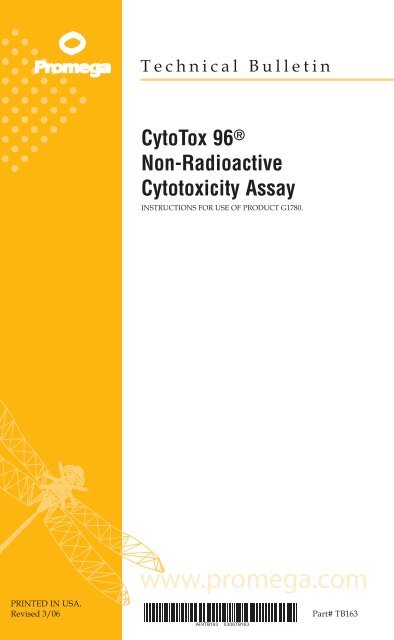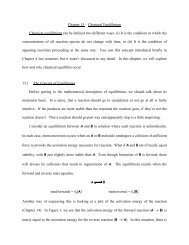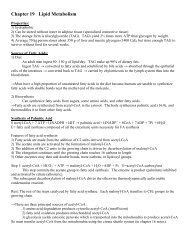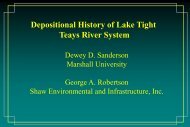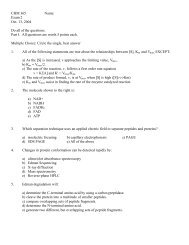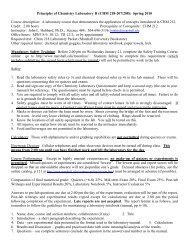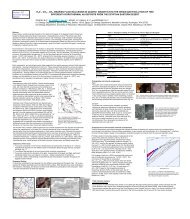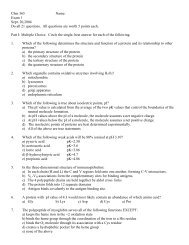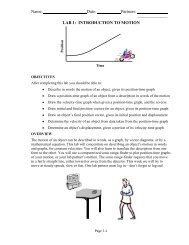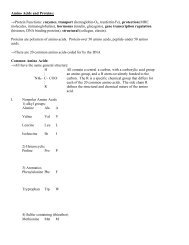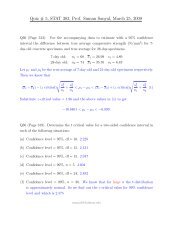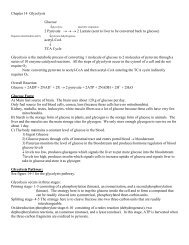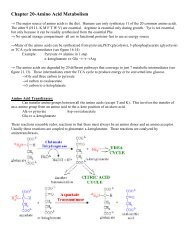CytoTox 96(R) Non-Radioactive Cytotoxicity Assay Technical ...
CytoTox 96(R) Non-Radioactive Cytotoxicity Assay Technical ...
CytoTox 96(R) Non-Radioactive Cytotoxicity Assay Technical ...
Create successful ePaper yourself
Turn your PDF publications into a flip-book with our unique Google optimized e-Paper software.
<strong>Technical</strong> Bulletin<br />
<strong>CytoTox</strong> <strong>96</strong> ®<br />
<strong>Non</strong>-<strong>Radioactive</strong><br />
<strong>Cytotoxicity</strong> <strong>Assay</strong><br />
INSTRUCTIONS FOR USE OF PRODUCT G1780.<br />
PRINTED IN USA.<br />
Revised 3/06<br />
AF9TB163 0306TB163<br />
Part# TB163
<strong>CytoTox</strong> <strong>96</strong> ® <strong>Non</strong>-<strong>Radioactive</strong><br />
<strong>Cytotoxicity</strong> <strong>Assay</strong><br />
All technical literature is available on the Internet at www.promega.com/tbs/<br />
Please visit the web site to verify that you are using the most current version of this<br />
<strong>Technical</strong> Bulletin. Please contact Promega <strong>Technical</strong> Services if you have questions on use<br />
of this system. E-mail: techserv@promega.com.<br />
I. Description..........................................................................................................1<br />
II. Product Components and Storage Conditions ............................................4<br />
III. General Considerations....................................................................................4<br />
A. Background Absorbance Corrections................................................................4<br />
B. <strong>CytoTox</strong> <strong>96</strong> ® <strong>Assay</strong> Controls...............................................................................5<br />
IV. Optimization of Target Cell Number............................................................5<br />
A. <strong>Assay</strong> Plate Setup .................................................................................................5<br />
B. Cell Lysis and Supernatant Harvest..................................................................7<br />
C. LDH Measurement...............................................................................................7<br />
V. Cell-Mediated <strong>Cytotoxicity</strong> <strong>Assay</strong>..................................................................8<br />
A. <strong>Assay</strong> Plate Setup .................................................................................................8<br />
B. Cell Culture and Supernatant Harvest .............................................................9<br />
C. LDH Measurement.............................................................................................10<br />
D. Calculation of Results ........................................................................................10<br />
VI. <strong>Assay</strong>s Using A Single Population of Cells ...............................................12<br />
A. Total Cell Number <strong>Assay</strong>..................................................................................12<br />
B. <strong>Cytotoxicity</strong> <strong>Assay</strong> .............................................................................................14<br />
VII. Troubleshooting...............................................................................................15<br />
VIII. References .........................................................................................................16<br />
IX. Appendix ...........................................................................................................17<br />
A. Composition of Buffers and Solutions ............................................................17<br />
B. Related Products.................................................................................................17<br />
I. Description<br />
The <strong>CytoTox</strong> <strong>96</strong> ® <strong>Non</strong>-<strong>Radioactive</strong> <strong>Cytotoxicity</strong> <strong>Assay</strong> is a colorimetric<br />
alternative to 51 Cr release cytotoxicity assays. The <strong>CytoTox</strong> <strong>96</strong> ® <strong>Assay</strong><br />
quantitatively measures lactate dehydrogenase (LDH), a stable cytosolic<br />
enzyme that is released upon cell lysis, in much the same way as 51 Cr is<br />
released in radioactive assays. Released LDH in culture supernatants is<br />
measured with a 30-minute coupled enzymatic assay, which results in the<br />
conversion of a tetrazolium salt (INT) into a red formazan product. The amount<br />
Promega Corporation · 2800 Woods Hollow Road · Madison, WI 53711-5399 USA<br />
Toll Free in USA 800-356-9526 · Phone 608-274-4330 · Fax 608-277-2516 · www.promega.com<br />
Printed in USA.<br />
Part# TB163<br />
Revised 3/06 Page 1
I. Description (continued)<br />
of color formed is proportional to the number of lysed cells. Visible wavelength<br />
absorbance data are collected using a standard <strong>96</strong>-well plate reader. Methods<br />
for determining LDH using tetrazolium salts in conjunction with diaphorase or<br />
alternate electron acceptors have been used for several years (1). Variations on<br />
this technology have been reported for measuring natural cytotoxicity and are<br />
identical (within experimental error) to values determined in parallel 51 Cr<br />
release assays (2,3).<br />
The general chemical reactions of the <strong>CytoTox</strong> <strong>96</strong> ® <strong>Assay</strong> are as follows:<br />
LDH<br />
NAD + + lactate → pyruvate + NADH<br />
Diaphorase<br />
NADH + INT → NAD+ + formazan (red)<br />
Applications of the <strong>CytoTox</strong> <strong>96</strong> ® <strong>Assay</strong><br />
• cell-mediated cytotoxicity (4)<br />
• cytotoxicity mediated by chemicals or other agents (5–8)<br />
• total cell number (9)<br />
Advantages of the <strong>CytoTox</strong> <strong>96</strong> ® <strong>Assay</strong><br />
• eliminates labeling of cells before experiment<br />
• eliminates paperwork and safety issues of radioactivity<br />
• allows use of standard plate reader<br />
• can reveal early, low-level cytotoxicity<br />
Selected Citations Using the <strong>CytoTox</strong> <strong>96</strong> ® <strong>Assay</strong><br />
• Spagnou, S., Miller, A.D. and Keller, M. (2004) Lipidic carriers of siRNA: Differences in the<br />
formulation, cellular uptake, and delivery with plasmid DNA. Biochemistry 43, 13348–56.<br />
The <strong>CytoTox</strong> <strong>96</strong> ® <strong>Non</strong>-<strong>Radioactive</strong> <strong>Cytotoxicity</strong> <strong>Assay</strong> was used to determine the cytotoxic<br />
effect of lipophilic transfection reagents commonly used for siRNA transfection. Data are<br />
presented as the percent cell death observed in HeLa and IGROV-1 cells at 24 hours posttransfection.<br />
• Hernández, J.M. et al. (2003) Novel kidney cancer immunotherapy based on the granulocytemacrophage<br />
colony-stimulating factor and carbonic anhydrase IX fusion gene. Clin. Cancer<br />
Res. 9, 1906–16.<br />
The <strong>CytoTox</strong> <strong>96</strong> ® <strong>Non</strong>-<strong>Radioactive</strong> <strong>Cytotoxicity</strong> <strong>Assay</strong> was used to determine specific<br />
cytotoxicity of human dendritic cells transduced with adenoviruses encoding a fusion<br />
protein of granulocyte-macrophage colony stimulating factor and carbonic anhydrase IX.<br />
For additional peer-reviewed articles that cite use of the <strong>CytoTox</strong> <strong>96</strong> ® <strong>Assay</strong>, visit:<br />
www.promega.com/citations/<br />
Promega Corporation · 2800 Woods Hollow Road · Madison, WI 53711-5399 USA<br />
Toll Free in USA 800-356-9526 · Phone 608-274-4330 · Fax 608-277-2516 · www.promega.com<br />
Part# TB163<br />
Printed in USA.<br />
Page 2 Revised 3/06
Add effector cells (at each effector cell concentration)<br />
for Effector Cell Spontaneous LDH Release Control<br />
and experimental wells.<br />
Add target cells to experimental wells.<br />
Add cells for Target Cell<br />
Spontaneous LDH Release Control.<br />
Add cells for Target Cell<br />
Maximum LDH Release Control.<br />
<strong>Assay</strong><br />
Plate<br />
Setup<br />
Add culture medium and Lysis Solution (10X)<br />
for Volume Correction Control.<br />
Add culture medium for Culture Medium<br />
Background Control.<br />
Centrifuge plate 250 x g for 4 minutes.<br />
Incubate 4 hours at 37°C.<br />
Add Lysis Solution (10X) to Target Cell Maximum LDH<br />
Release Control 45 minutes prior to centrifugation.<br />
Centrifuge plate 250 x g for 4 minutes.<br />
Cell Culture<br />
and<br />
Supernatant<br />
Harvest<br />
Transfer 50µl supernatant to enzymatic assay plate.<br />
(Optional) Add 50µl of a 1:5,000 dilution of<br />
LDH Positive Control to separate well.<br />
Reconstitute Substrate Mix using <strong>Assay</strong> Buffer.<br />
Add 50µl reconstituted Substrate Mix to<br />
each well of enzymatic assay plate.<br />
LDH<br />
Measurement<br />
Cover plate and incubate 30 minutes<br />
at room temperature, protected from light.<br />
Add 50µl Stop Solution to each well.<br />
Record absorbance 490nm.<br />
0924MA08_9A<br />
Figure 1. <strong>CytoTox</strong> <strong>96</strong> ® <strong>Non</strong>-<strong>Radioactive</strong> <strong>Cytotoxicity</strong> <strong>Assay</strong> procedure.<br />
Promega Corporation · 2800 Woods Hollow Road · Madison, WI 53711-5399 USA<br />
Toll Free in USA 800-356-9526 · Phone 608-274-4330 · Fax 608-277-2516 · www.promega.com<br />
Printed in USA.<br />
Part# TB163<br />
Revised 3/06 Page 3
II.<br />
Product Components and Storage Conditions<br />
Product Size Cat.#<br />
<strong>CytoTox</strong> <strong>96</strong> ® <strong>Non</strong>-<strong>Radioactive</strong> <strong>Cytotoxicity</strong> <strong>Assay</strong> 1,000 assays G1780<br />
For Laboratory Use. Includes:<br />
• 5 vials Substrate Mix<br />
• 60ml <strong>Assay</strong> Buffer<br />
• 25µl LDH Positive Control<br />
• 3ml Lysis Solution (10X)<br />
• 65ml Stop Solution<br />
• 1 Protocol<br />
Storage Conditions: Store Substrate Mix and <strong>Assay</strong> Buffer frozen at –20°C.<br />
Reconstituted Substrate Mix may be stored for 6–8 weeks at –20°C without loss<br />
of activity. Store LDH Positive Control, Lysis Solution (10X) and Stop Solution<br />
at 4°C.<br />
Note: Upon storage, a precipitate might form in the <strong>Assay</strong> Buffer. This<br />
precipitate does not affect assay performance. The precipitate may be removed<br />
by centrifugation at 300 × g for 5 minutes. Twelve milliliters of the supernatant<br />
can then be used to reconstitute the substrate mix.<br />
III.<br />
General Considerations<br />
III.A. Background Absorbance Corrections<br />
Two factors in tissue culture medium can contribute to background<br />
absorbance using the <strong>CytoTox</strong> <strong>96</strong> ® <strong>Assay</strong>: phenol red from medium and LDH<br />
from animal sera. Background absorbance from both factors can be corrected<br />
for by including a culture medium background control. The absorbance value<br />
determined from this control is used to normalize the absorbance values<br />
obtained from the other samples (see Section V.D). Background absorbance<br />
from phenol red also may be eliminated by using a phenol red-free medium.<br />
The quantity of LDH in animal sera will vary depending on several<br />
parameters, including the species and the health or treatment of the animal<br />
prior to collecting serum. Human AB serum is relatively low in LDH activity,<br />
whereas calf serum is relatively high. The concentration of serum can be<br />
decreased to reduce the amount of LDH contributing to background<br />
absorbance (3). In general, decreasing the serum concentration to 5% will<br />
significantly reduce background without affecting cell viability. The use of<br />
1% BSA in place of serum is not recommended for cell-mediated cytotoxicity<br />
assays.<br />
Promega Corporation · 2800 Woods Hollow Road · Madison, WI 53711-5399 USA<br />
Toll Free in USA 800-356-9526 · Phone 608-274-4330 · Fax 608-277-2516 · www.promega.com<br />
Part# TB163<br />
Printed in USA.<br />
Page 4 Revised 3/06
III.B. <strong>CytoTox</strong> <strong>96</strong> ® <strong>Assay</strong> Controls<br />
The five controls listed below must be performed with the <strong>CytoTox</strong> <strong>96</strong> ® <strong>Assay</strong>.<br />
Controls #2 and #3 are identical to those in a standard 51 Cr release assay<br />
(target cell spontaneous release and target cell maximum release). The three<br />
additional controls account for LDH activity contributed from other sources.<br />
1. Effector Cell Spontaneous LDH Release: Corrects for spontaneous release<br />
of LDH from effector cells.<br />
2. Target Cell Spontaneous LDH Release: Corrects for spontaneous release<br />
of LDH from target cells.<br />
3. Target Cell Maximum LDH Release: Required in calculations to determine<br />
100% release of LDH.<br />
4. Volume Correction Control: Corrects for volume change caused by<br />
addition of Lysis Solution (10X).<br />
Note: The Volume Correction Control may be eliminated if freeze-thaw<br />
lysis is substituted for addition of Lysis Solution (10X) to obtain Target Cell<br />
Maximum LDH Release.<br />
5. Culture Medium Background: Corrects for LDH activity contributed by<br />
serum in culture medium and the varying amounts of phenol red in the<br />
culture medium.<br />
IV.<br />
Optimization of Target Cell Number<br />
Because various target cell types (YAC-1, K562, Daudi, etc.) contain different<br />
amounts of LDH, we recommend a preliminary experiment using your target<br />
cell population(s) to determine the optimum number of target cells to use with<br />
the <strong>CytoTox</strong> <strong>96</strong> ® <strong>Assay</strong> and to ensure an adequate signal-to-noise ratio (Figure<br />
2). The LDH Positive Control supplied may be used to verify that the LDH<br />
assay is functioning properly.<br />
Materials to Be Supplied by the User<br />
(Solution composition is provided in Section IX.A.)<br />
• round- or V-bottom <strong>96</strong>-well tissue culture plates<br />
• multichannel pipettor<br />
• Optional: PBS + 1% BSA (bovine serum albumin)<br />
IV.A. <strong>Assay</strong> Plate Setup<br />
1. Prepare serial dilutions of each target cell type in triplicate or quadruplicate<br />
sets of wells in a round- or V-bottom <strong>96</strong>-well tissue culture plate. Use the<br />
same medium and final volume that will be used for cytotoxicity assays.<br />
For example, if you normally co-culture 50µl/well of target cells with<br />
50µl/well of effector cells, prepare serial dilutions in 100µl/well.<br />
Promega Corporation · 2800 Woods Hollow Road · Madison, WI 53711-5399 USA<br />
Toll Free in USA 800-356-9526 · Phone 608-274-4330 · Fax 608-277-2516 · www.promega.com<br />
Printed in USA.<br />
Part# TB163<br />
Revised 3/06 Page 5
IV.A. <strong>Assay</strong> Plate Setup (continued)<br />
2. Prepare a triplicate or quadruplicate set of wells for the Culture Medium<br />
Background without cells.<br />
3. Optional: If you wish to perform an LDH positive control, gently mix the<br />
LDH Positive Control by vortexing and then dilute 2µl of this solution into<br />
10ml of PBS + 1% BSA (1:5,000 dilution). Prepare this stock solution fresh<br />
for each use. Use a volume equivalent to that used for the wells containing<br />
cells. Triplicate or quadruplicate wells are recommended.<br />
Prepare target cell dilutions<br />
(0, 5,000, 10,000, 20,000/100µl).<br />
Add 100µl/well to V-bottom <strong>96</strong>-well plate.<br />
Rupture cells with Lysis Solution<br />
(or freeze-thaw step).<br />
Centrifuge plate at 250 × g for 4 minutes.<br />
Transfer 50µl supernatant to<br />
enzymatic assay plate.<br />
Reconstitute Substrate Mix using <strong>Assay</strong> Buffer.<br />
Add 50µl/well reconstituted Substrate Mix<br />
to enzymatic assay plate.<br />
Incubate for 30 minutes at<br />
room temperature, protected from light.<br />
Add 50µl Stop Solution to each well.<br />
Record absorbance at 490nm.<br />
3597MA12_1A<br />
Figure 2. Optimization of target cell number.<br />
Promega Corporation · 2800 Woods Hollow Road · Madison, WI 53711-5399 USA<br />
Toll Free in USA 800-356-9526 · Phone 608-274-4330 · Fax 608-277-2516 · www.promega.com<br />
Part# TB163<br />
Printed in USA.<br />
Page 6 Revised 3/06
IV.B. Cell Lysis and Supernatant Harvest<br />
1. Add 10µl of Lysis Solution (10X) per 100µl of medium to all wells to lyse<br />
cells.<br />
2. Incubate for 45 minutes in a humidified chamber at 37°C, 5% CO 2 .<br />
Note: As an alternative to Steps 1 and 2, lyse the cells by incubating the<br />
plate at –70°C for approximately 30 minutes followed by thawing at 37°C<br />
for 15 minutes. Proceed to Step 3.<br />
3. Centrifuge the plate at 250 × g for 4 minutes.<br />
IV.C. LDH Measurement<br />
1. Transfer 50µl aliquots from all wells to a fresh <strong>96</strong>-well flat-bottom<br />
(enzymatic assay) plate.<br />
2. Thaw the <strong>Assay</strong> Buffer, remove 12ml and promptly store the unused<br />
portion at –20°C. A 37°C water bath may be used to thaw the <strong>Assay</strong> Buffer,<br />
but it should not be left at 37°C longer than necessary.<br />
Note: Upon storage, a precipitate might form in the <strong>Assay</strong> Buffer. This<br />
precipitate does not affect assay performance. The precipate may be<br />
removed by centrifugation at 300 × g for 5 minutes. Twelve milliliters of<br />
the supernatant can then be used to reconstitute the substrate mix.<br />
Warm the 12ml of <strong>Assay</strong> Buffer to room temperature (keep protected from<br />
light). Add the 12ml of room temperature <strong>Assay</strong> Buffer to a bottle of<br />
Substrate Mix. Invert and shake gently to dissolve the substrate. One bottle<br />
will supply enough substrate for two <strong>96</strong>-well plates. Once resuspended,<br />
protect the substrate from strong direct light and use immediately.<br />
3. Add 50µl of the reconstituted Substrate Mix to each well of the plate. Cover<br />
the plate with foil or a small opaque box to protect it from light. Incubate at<br />
room temperature for 30 minutes.<br />
Note: Store unused portions of the reconstituted Substrate Mix tightly<br />
capped at –20°C for ≤6–8 weeks.<br />
4. Add 50µl of Stop Solution to each well.<br />
5. Pop any large bubbles using a syringe needle, and record the absorbance at<br />
490 or 492nm within one hour after the addition of Stop Solution.<br />
6. Determine the concentration of target cells yielding absorbance values at<br />
least two times the background absorbance of the medium control.<br />
Note: If you normally co-culture 100µl/well of target cells with 100µl/well<br />
of effector cells, target cell sensitivity can be increased by co-culturing the<br />
same number of cells in 50µl/well volumes. By doing this, the<br />
concentration of released LDH is increased.<br />
Promega Corporation · 2800 Woods Hollow Road · Madison, WI 53711-5399 USA<br />
Toll Free in USA 800-356-9526 · Phone 608-274-4330 · Fax 608-277-2516 · www.promega.com<br />
Printed in USA.<br />
Part# TB163<br />
Revised 3/06 Page 7
V. Cell-Mediated <strong>Cytotoxicity</strong> <strong>Assay</strong><br />
V.A. <strong>Assay</strong> Plate Setup<br />
Set up the <strong>96</strong>-well assay plate using the following guidelines. Perform each<br />
experimental and control reaction in triplicate or quadruplicate. A suggested<br />
plate setup is shown in Figure 3.<br />
1. Effector Cell Spontaneous LDH Release: Add effector cells at each<br />
concentration used in the experimental setup to a triplicate or<br />
quadruplicate set of wells containing medium to obtain the effector cell<br />
spontaneous release. The final volume must be the same as in the experimental<br />
wells (use medium alone with no cells to bring up the volume).<br />
2. Experimental Wells: Add a constant number of target cells (determined<br />
in Section IV) to all experimental wells of a V- or round-bottom <strong>96</strong>-well<br />
culture plate. Add various numbers of effector cells to triplicate or<br />
quadruplicate sets of wells to test several effector:target cell ratios. The<br />
final combined volume should be a minimum of 100µl/well.<br />
3. Target Cell Spontaneous LDH Release: Add target cells (concentration<br />
determined in Section IV) to a triplicate or quadruplicate set of wells<br />
containing culture medium. The final volume must be the same as the<br />
experimental wells containing both target and effector cells (use culture<br />
medium to adjust volume).<br />
4. Target Cell Maximum LDH Release: Add target cells (concentration<br />
determined in Section IV) to a triplicate or quadruplicate set of wells<br />
containing culture medium. The final volume must be the same as the<br />
experimental wells. Add 10µl of the Lysis Solution (10X) per 100µl of<br />
culture medium. This will result in a concentration of approximately 0.8%<br />
Triton ® X-100, which should yield complete lysis of target cells. Incubate<br />
target cells in presence of Lysis Solution for 45 minutes prior to harvesting<br />
the supernatants.<br />
5. Volume Correction Control: Add 10µl of Lysis Solution (10X) to a triplicate<br />
or quadruplicate set of wells containing 100µl of culture medium (without<br />
cells). This control is recommended to correct for the volume increase<br />
caused by the addition of Lysis Solution (10X). This volume change affects<br />
the concentration of phenol red and serum, which contribute to the<br />
absorbance readings.<br />
6. Culture Medium Background: Add 100µl of culture medium to a triplicate<br />
or quadruplicate set of wells. This control is required to correct for<br />
contributions caused by phenol red and LDH activity that may be present<br />
in serum-containing culture medium.<br />
7. LDH Positive Control (optional): We have included a positive control<br />
(bovine heart LDH) to verify performance of other system components. If<br />
you wish to perform an LDH positive control, gently mix the LDH Positive<br />
Control by vortexing and then dilute 2µl of this solution into 10ml of PBS +<br />
1% BSA (1:5,000 dilution). Prepare this stock solution fresh for each use.<br />
Promega Corporation · 2800 Woods Hollow Road · Madison, WI 53711-5399 USA<br />
Toll Free in USA 800-356-9526 · Phone 608-274-4330 · Fax 608-277-2516 · www.promega.com<br />
Part# TB163<br />
Printed in USA.<br />
Page 8 Revised 3/06
The final volume must be the same as in the experimental wells. A 1:5,000<br />
dilution of the LDH Positive Control will give approximately the same<br />
level of enzyme found in 13,500 lysed L929 fibroblast cells. Triplicate or<br />
quadruplicate wells are recommended.<br />
8. Centrifuge the assay plate at 250 × g for 4 minutes to ensure effector and<br />
target cell contact.<br />
1 2 3 4 5 6 7 8 9 10 11 12<br />
A<br />
B<br />
C<br />
D<br />
Target Spontaneous Release<br />
Culture Medium Background<br />
Effector Cell Spontaneous Release<br />
E<br />
F<br />
G<br />
H<br />
Target Maximum Release<br />
Volume Correction Control<br />
Experimental<br />
10:1 5:1 2.5:1 1.25:1 0.62:1 0.31:1 0.16:1 0.08:1 0.04:1 0.02:1<br />
Effector:Target Cell Ratios<br />
Figure 3. Representative <strong>CytoTox</strong> <strong>96</strong> ® <strong>Non</strong>-<strong>Radioactive</strong> <strong>Cytotoxicity</strong> <strong>Assay</strong> plate<br />
setup. The drawing is a representation of a <strong>96</strong>-well plate containing the<br />
experimental and control wells necessary for the <strong>CytoTox</strong> <strong>96</strong> ® <strong>Assay</strong>. Perform each<br />
experimental and control reaction in triplicate or quadruplicate.<br />
V.B. Cell Culture and Supernatant Harvest<br />
1. Incubate the cytotoxicity assay plate for 4 hours in a humidified chamber at<br />
37°C, 5% CO 2 . A minimum 4-hour incubation is needed for sufficient<br />
contact between target and effector cells.<br />
2. Forty-five minutes prior to harvesting supernatants, add 10µl of Lysis<br />
Solution (10X) for every 100µl of target cells to the wells containing the<br />
Target Cell Maximum LDH Release Control.<br />
Note: If the target cells are not completely lysed (as determined by<br />
microscopy), add another 5µl of Lysis Solution (10X).<br />
3. After the 4-hour incubation, centrifuge the plate at 250 × g for 4 minutes.<br />
Promega Corporation · 2800 Woods Hollow Road · Madison, WI 53711-5399 USA<br />
Toll Free in USA 800-356-9526 · Phone 608-274-4330 · Fax 608-277-2516 · www.promega.com<br />
Printed in USA.<br />
Part# TB163<br />
Revised 3/06 Page 9
V.C. LDH Measurement<br />
1. Transfer 50µl aliquots from all wells using a multichannel pipettor to a<br />
fresh <strong>96</strong>-well flat-bottom (enzymatic assay) plate.<br />
2. Thaw the <strong>Assay</strong> Buffer, remove 12ml and promptly store the unused<br />
portion at –20°C. A 37°C water bath may be used to thaw the <strong>Assay</strong> Buffer,<br />
but it should not be left at 37°C longer than necessary.<br />
Warm the 12ml of <strong>Assay</strong> Buffer to room temperature (keep protected from<br />
light). Add the 12ml of room temperature <strong>Assay</strong> Buffer to one bottle of<br />
Substrate Mix. Invert and shake gently to dissolve the Substrate Mix.<br />
One bottle will supply enough substrate for two <strong>96</strong>-well plates. Once<br />
resuspended, protect the Substrate from strong direct light and use<br />
immediately.<br />
3. Add 50µl of reconstituted Substrate Mix to each well of the enzymatic<br />
assay plate containing samples transferred from the cytotoxicity assay<br />
plate. Cover the plate with foil or an opaque box to protect it from light<br />
and incubate for 30 minutes at room temperature.<br />
Note: Store unused portions of the reconstituted Substrate Mix tightly<br />
capped at –20°C for ≤6–8 weeks.<br />
4. Add 50µl of Stop Solution to each well.<br />
5. Pop any large bubbles using a syringe needle, and record the absorbance at<br />
490 or 492nm within 1 hour after the addition of Stop Solution.<br />
V.D. Calculation of Results<br />
1. Subtract the average of absorbance values of the Culture Medium<br />
Background from all absorbance values of Experimental, Target Cell<br />
Spontaneous LDH Release and Effector Cell Spontaneous LDH Release.<br />
2. Subtract the average of the absorbance values of the Volume Correction<br />
Control from the absorbance values obtained for the Target Cell Maximum<br />
LDH Release Control.<br />
3. Use the corrected values obtained in Steps 1 and 2 in the following formula<br />
to compute percent cytotoxicity for each effector:target cell ratio.<br />
% <strong>Cytotoxicity</strong> =<br />
Experimental – Effector Spontaneous – Target Spontaneous × 100<br />
Target Maximum – Target Spontaneous<br />
Promega Corporation · 2800 Woods Hollow Road · Madison, WI 53711-5399 USA<br />
Toll Free in USA 800-356-9526 · Phone 608-274-4330 · Fax 608-277-2516 · www.promega.com<br />
Part# TB163<br />
Printed in USA.<br />
Page 10 Revised 3/06
1 2 3 4 5 6 7 8 9 10 11 12<br />
A<br />
B<br />
C<br />
D<br />
Target Spontaneous Release<br />
.477<br />
.469<br />
.471<br />
.474<br />
Culture Medium Background<br />
.478<br />
.436<br />
.470<br />
.472<br />
.641<br />
.660<br />
.644<br />
.661<br />
.549<br />
.541<br />
.548<br />
.552<br />
.501<br />
.513<br />
.521<br />
.528<br />
.515 .490 .485 .503<br />
.501 .478 .478 .495<br />
Effector Cell Spontaneous Release<br />
.499 .498 .470 .502<br />
.501 .491 .483 .490<br />
.4<strong>96</strong><br />
.482<br />
.476<br />
.485<br />
.459<br />
.451<br />
.474<br />
.484<br />
.480<br />
.472<br />
.471<br />
.475<br />
E<br />
F<br />
G<br />
H<br />
Target Maximum Release<br />
.638<br />
.655<br />
.664<br />
.680<br />
Volume Correction Control<br />
.443<br />
.447<br />
.446<br />
.440<br />
.816<br />
.809<br />
.824<br />
.829<br />
.686<br />
.705<br />
.697<br />
.709<br />
.619<br />
.610<br />
.620<br />
.593<br />
.556<br />
.554<br />
.558<br />
.563<br />
.499<br />
.529<br />
.501<br />
.495<br />
.515<br />
.511<br />
Experimental<br />
.520 .497 .495<br />
.523 .511 .511<br />
.481<br />
.477<br />
.483<br />
.485<br />
.497<br />
.504<br />
.462<br />
.489<br />
.478<br />
.486<br />
.484<br />
.493<br />
10:1 5:1 2.5:1 1.25:1 0.62:1 0.31:1 0.16:1 0.08:1 0.04:1 0.02:1<br />
Effector: Target Cell Ratios<br />
Figure 4. Representative data from a <strong>CytoTox</strong> <strong>96</strong> ® <strong>Non</strong>-<strong>Radioactive</strong> <strong>Cytotoxicity</strong><br />
<strong>Assay</strong> performed at Promega. The assay conditions used to generate these data are<br />
described previously in this section.<br />
Sample Calculation<br />
The following sample calculations are based on the data shown in Figure 4, obtained<br />
using the <strong>CytoTox</strong> <strong>96</strong> ® <strong>Assay</strong> and the following experimental conditions.<br />
Effector Cells: NK/LAK cells generated from male C3H/HeJ mice. Nylon woolnonadherent<br />
spleen cells were cultured with rhIL-2 (500ng/ml) for 5 days prior to<br />
use in the cytotoxicity assay.<br />
Target Cells: YAC-1 cells maintained as an upright suspension line prior to use in<br />
the assay.<br />
Culture Medium in <strong>Assay</strong>: RPMI 1640 (containing phenol red) + 15mM HEPES +<br />
5% FBS.<br />
Plate: <strong>96</strong>-well round-bottom plate.<br />
Target Cell Plating: 10,000 cells/well in 50µl medium.<br />
Effector Cell Plating: Ratios of 10:1 to 0.02:1 in 50µl medium.<br />
Incubation: Four hours at 37°C, 5% CO 2 .<br />
Promega Corporation · 2800 Woods Hollow Road · Madison, WI 53711-5399 USA<br />
Toll Free in USA 800-356-9526 · Phone 608-274-4330 · Fax 608-277-2516 · www.promega.com<br />
Printed in USA.<br />
Part# TB163<br />
Revised 3/06 Page 11
Sample Calculation (continued)<br />
1. Experimental, 10:1 cell ratio (avg.) – Culture Medium Background (avg.) =<br />
0.819 – 0.464 = 0.355<br />
Target Spontaneous (avg.) – Culture Medium Background (avg.) =<br />
0.472 – 0.464 = 0.008<br />
Effector Spontaneous (avg.) – Culture Medium Background (avg.) =<br />
0.651 – 0.464 = 0.187<br />
2. Target Maximum (avg.) – Volume Correction Control (avg.) =<br />
0.659 – 0.444 = 0.215<br />
– Effector – Target<br />
3. % <strong>Cytotoxicity</strong> = Experimental Spontaneous Spontaneous × 100<br />
Target Maximum – Target Spontaneous<br />
% <strong>Cytotoxicity</strong> = 0.355 – 0.187 – 0.008 × 100<br />
0.215 – 0.008<br />
= 77.3% for the 10:1 effector:target cell ratio<br />
VI.<br />
<strong>Assay</strong>s Using A Single Population of Cells<br />
VI.A. Total Cell Number <strong>Assay</strong><br />
The <strong>CytoTox</strong> <strong>96</strong> ® <strong>Assay</strong> indirectly measures the lactate dehydrogenase activity<br />
present in the cytoplasm of intact cells. Cell quantitation, therefore, can occur<br />
only if the cells are lysed to release the LDH present in the cell. Certain<br />
detergents (SDS and cetrimide) have been shown to inhibit the generation of<br />
the final red formazan product. However, the Lysis Solution included with the<br />
<strong>CytoTox</strong> <strong>96</strong> ® <strong>Assay</strong> can be used for cell lysis and does not interfere with the<br />
assay when used as recommended.<br />
Cell samples of interest are lysed by adding 15µl of Lysis 10X Solution (9%<br />
(v/v) Triton ® X-100 in water) per 100µl of culture medium, followed by<br />
incubation at 37°C for 45–60 minutes. Sample supernatants (50µl) are then<br />
transferred to a fresh <strong>96</strong>-well enzymatic assay plate. Reconstituted Substrate<br />
Mix (50µl) is added to each supernatant sample, and the enzymatic reaction is<br />
allowed to proceed for 30 minutes at room temperature, protected from light.<br />
The enzymatic assay is then stopped by adding 50µl/well of the Stop Solution.<br />
The plate can be read at 490nm using an ELISA plate reader. The number of<br />
cells present will be directly proportional to the absorbance values, which<br />
represent LDH activity. Resulting data can be plotted with absorbance at<br />
490nm values along the “y-axis” and cell number along the “x-axis.”<br />
Figure 5 summarizes these steps.<br />
Promega Corporation · 2800 Woods Hollow Road · Madison, WI 53711-5399 USA<br />
Toll Free in USA 800-356-9526 · Phone 608-274-4330 · Fax 608-277-2516 · www.promega.com<br />
Part# TB163<br />
Printed in USA.<br />
Page 12 Revised 3/06
Add cells to experimental wells.<br />
Add culture medium to separate wells<br />
for background control.<br />
Add Lysis Solution (10X) to all wells.<br />
Incubate for 45–60 minutes at 37°C.<br />
Transfer 50µl supernatant to<br />
enzymatic assay plate.<br />
(Optional) Add 1:5,000 dilution of<br />
LDH Positive Control to an empty well without cells.<br />
Reconstitute Substrate Mix using <strong>Assay</strong> Buffer.<br />
Add 50µl reconstituted Substrate Mix<br />
to each well of enzymatic assay plate.<br />
Cover plate and incubate for 30 minutes<br />
at room temperature, protected from light.<br />
Add 50µl Stop Solution to each well.<br />
Record absorbance at 490nm.<br />
3594MA12_1A<br />
Figure 5. Modified <strong>CytoTox</strong> <strong>96</strong> ® <strong>Non</strong>-<strong>Radioactive</strong> <strong>Cytotoxicity</strong> <strong>Assay</strong> procedure<br />
for detecting total cell number.<br />
Promega Corporation · 2800 Woods Hollow Road · Madison, WI 53711-5399 USA<br />
Toll Free in USA 800-356-9526 · Phone 608-274-4330 · Fax 608-277-2516 · www.promega.com<br />
Printed in USA.<br />
Part# TB163<br />
Revised 3/06 Page 13
VI.B. <strong>Cytotoxicity</strong> <strong>Assay</strong><br />
The <strong>CytoTox</strong> <strong>96</strong> ® <strong>Assay</strong> can also be used to measure death of a single cell type<br />
(i.e., without an effector cell) in culture, such as after treatment with a<br />
cytotoxic drug (10). An example protocol, where the <strong>CytoTox</strong> <strong>96</strong> ® <strong>Assay</strong> was<br />
used to measure cell death initiated by transfected N-methyl-D-aspartate<br />
(NMDA) receptors (11), is given in Figure 6.<br />
The Procedure<br />
Incubate HEK 293 cells transfected with<br />
the required NMDA receptor subunit genes<br />
using calcium phosphate transfection (12).<br />
After 20 hours, collect medium samples to assess LDH<br />
released due to cell death. Centrifuge at 4°C for 5 minutes,<br />
dilute with medium and transfer to a <strong>96</strong>-well plate.<br />
Assess maximum LDH activity by freeze-thaw lysing<br />
the transfected cells, collecting volumes of the<br />
resulting medium and processing as above.<br />
Measure LDH spontaneously released from cells and correct<br />
for phenol red and endogenous LDH activity in the serum.<br />
The <strong>Assay</strong><br />
Reconstitute Substrate Mix (50µl) and add to each sample.<br />
Incubate assay plates for 30 minutes at<br />
room temperature, protected from light.<br />
Add Stop Solution and record absorbance at 490nm.<br />
Subtract background values from the sample readings.<br />
Determine % cell death using the formula:<br />
% Cytoxicity =<br />
Experimental LDH release (OD490)<br />
Maximum LDH release (OD 490)<br />
3595MA12_1A<br />
Figure 6. Modified <strong>CytoTox</strong> <strong>96</strong> ® <strong>Non</strong>-<strong>Radioactive</strong> <strong>Cytotoxicity</strong> <strong>Assay</strong> to measure<br />
cell death initiated by transfected NMDA receptors (11) (cytotoxicity using one<br />
cell type).<br />
Promega Corporation · 2800 Woods Hollow Road · Madison, WI 53711-5399 USA<br />
Toll Free in USA 800-356-9526 · Phone 608-274-4330 · Fax 608-277-2516 · www.promega.com<br />
Part# TB163<br />
Printed in USA.<br />
Page 14 Revised 3/06
VII. Troubleshooting<br />
For questions not addressed here, please contact your local Promega Branch Office or Distributor.<br />
Contact information available at: www.promega.com. E-mail: techserv@promega.com<br />
Symptoms<br />
High background absorbance<br />
High values for Effector Cell or<br />
Target Cell Spontaneous LDH<br />
Release Controls<br />
Low % cytotoxicity observed<br />
Absorbance values above linear<br />
range of plate reader<br />
Causes and Comments<br />
Endogenous LDH in animal sera in culture<br />
medium. This background absorbance normally<br />
is accounted for by the Culture Medium<br />
Background. To reduce background absorbance,<br />
change the source of serum or reduce the serum<br />
concentration. LDH activity in sera vary, with<br />
human AB serum, horse serum, fetal bovine<br />
serum and calf serum containing increasing<br />
levels of LDH activity. In general, decreasing<br />
serum concentration to 5% will significantly<br />
reduce background without affecting cell<br />
viability. The use of 1% BSA in place of serum is<br />
not recommended for cell-mediated cytotoxicity<br />
assays.<br />
Phenol red in culture medium. This background<br />
absorbance normally is accounted for by the<br />
Culture Medium Background. A phenol redfree<br />
medium may be used, if desired.<br />
“Leaky” cell membranes due to suboptimal<br />
culture conditions or handling. Keep cell<br />
densities low (
VII. Troubleshooting (continued)<br />
Symptoms<br />
Low overall absorbance values<br />
Low value for Target Cell<br />
Maximum Release<br />
Causes and Comments<br />
Plate reader set at incorrect absorbance. Set<br />
plate reader to 490 or 492nm and repeat<br />
absorbance readings.<br />
Substrate degraded by light. Check that the<br />
substrate preparation and LDH reaction<br />
(Section V.C, Steps 2 and 3) are performed<br />
while protected from light.<br />
Target cell number not optimized. Optimize the<br />
number of target cells added to the assay<br />
(Section IV).<br />
VIII. References<br />
1. Nachlas, M.M. et al. (1<strong>96</strong>0) The determination of lactic dehydrogenase with a<br />
tetrazolium salt. Anal. Biochem. 1, 317–26.<br />
2. Korzeniewski, C. and Callewaert, D.M. (1983) An enzyme-release assay for natural<br />
cytotoxicity. J. Immunol. Meth. 64, 313–20.<br />
3. Decker, T. and Lohmann-Matthes, M.L. (1988) A quick and simple method for the<br />
quantitation of lactate dehydrogenase release in measurements of cellular cytotoxicity<br />
and tumor necrosis factor (TNF) activity. J. Immunol. Meth. 115, 61–9.<br />
4. Brander, C. et al. (1993) Carrier-mediated uptake and presentation of a major<br />
histocompatibility complex class I-restricted peptide. Eur. J. Immunol. 23, 3217–23.<br />
5. Behl, C. et al. (1994) Hydrogen peroxide mediates amyloid beta protein toxicity. Cell<br />
77, 817–27.<br />
6. Lappalainen, K. et al. (1994) Comparison of cell proliferation and toxicity assays using<br />
two cationic liposomes. Pharm. Res. 11, 1127–31.<br />
7. Allen, M.J. and Rushton, N. (1994) Use of the <strong>CytoTox</strong> <strong>96</strong> <strong>Assay</strong> in routine<br />
biocompatibility testing in vitro. Promega Notes 45, 7–10.<br />
8. Sinensky, M.C., Leiser, A.L. and Babich, H. (1995) Oxidative stress aspects of the<br />
cytotoxicity of carbamide peroxide: in vitro studies. Toxicol. Lett. 75, 101–9.<br />
9. Moravec, R. (1994) Total cell quantitation using the <strong>CytoTox</strong> <strong>96</strong> <strong>Non</strong>-<strong>Radioactive</strong><br />
<strong>Cytotoxicity</strong> <strong>Assay</strong>. Promega Notes 45, 11–12.<br />
10. Singer, C.A. et al. (1999) The mitogen-activated protein kinase pathway mediates<br />
estrogen neuroprotection after glutamate toxicity in primary cortical neurons. J.<br />
Neurosci. 19, 2455–63.<br />
11. Miroslav, C. et al. (1995) Using Promega’s <strong>CytoTox</strong> <strong>96</strong> ® <strong>Non</strong>-<strong>Radioactive</strong> <strong>Cytotoxicity</strong><br />
<strong>Assay</strong> to measure cell death mediated by NMDA receptor subunits. Promega Notes 51,<br />
21–22.<br />
12. Gorman, C.M., Gies, D.R. and McCray, G. (1990) Transient production of proteins<br />
using an adenovirus transformed cell line. DNA Prot. Eng. Technol. 2, 3.<br />
Promega Corporation · 2800 Woods Hollow Road · Madison, WI 53711-5399 USA<br />
Toll Free in USA 800-356-9526 · Phone 608-274-4330 · Fax 608-277-2516 · www.promega.com<br />
Part# TB163<br />
Printed in USA.<br />
Page 16 Revised 3/06
IX.<br />
Appendix<br />
IX.A. Composition of Buffers and Solutions<br />
PBS + 1% BSA<br />
0.2g/L KCl<br />
8.0g/L NaCl<br />
0.2g/L KH 2 PO 4<br />
1.15g/L Na 2 HPO 4<br />
1% (w/v) bovine serum albumin<br />
Dissolve in deionized water and filtersterilize<br />
before use.<br />
Lysis Solution (10X)<br />
9% (v/v) Triton ® X-100<br />
Stop Solution<br />
1M acetic acid<br />
IX.B. Related Products<br />
Product Size Cat.#<br />
<strong>CytoTox</strong>-ONE Homogeneous<br />
Membrane Integrity <strong>Assay</strong> 200–800 assays** G7890<br />
CellTiter-Glo ® Luminescent Cell Viability <strong>Assay</strong> 10 × 100ml** G7571<br />
CellTiter-Blue ® Cell Viability <strong>Assay</strong> 100ml** G8081<br />
CellTiter <strong>96</strong> ® AQ ueous One Solution<br />
Cell Proliferation <strong>Assay</strong>* 1,000 assays** G3580<br />
CellTiter <strong>96</strong> ® AQ ueous MTS Reagent Powder* 250mg** G1112<br />
CellTiter <strong>96</strong> ® AQ ueous <strong>Non</strong>-<strong>Radioactive</strong><br />
Cell Proliferation <strong>Assay</strong>* 1,000 assays** G5421<br />
CellTiter <strong>96</strong> ® <strong>Non</strong>-<strong>Radioactive</strong> Cell Proliferation <strong>Assay</strong>* 1,000 assays** G4000<br />
Apo-ONE ® Homogeneous Caspase-3/7 <strong>Assay</strong> 100ml G7791<br />
Caspase-Glo ® 3/7 <strong>Assay</strong>* 10ml** G8091<br />
Caspase-Glo ® 8 <strong>Assay</strong>* 10ml** G8201<br />
Caspase-Glo ® 9 <strong>Assay</strong>* 10ml** G8211<br />
*For Laboratory Use.<br />
**Available in additional sizes.<br />
© 1992–2006 Promega Corporation. All Rights Reserved.<br />
Apo-ONE, Caspase-Glo, CellTiter <strong>96</strong>, CellTiter-Blue, CellTiter-Glo, <strong>CytoTox</strong> <strong>96</strong> and pGEM are registered trademarks of<br />
Promega Corporation. <strong>CytoTox</strong>-ONE is a trademark of Promega Corporation.<br />
Triton is a registered trademark of Union Carbide Chemicals & Plastics Technology Corporation.<br />
Products may be covered by pending or issued patents or may have certain limitations. Please visit our Web site for more<br />
information.<br />
All prices and specifications are subject to change without prior notice.<br />
Product claims are subject to change. Please contact Promega <strong>Technical</strong> Services or access the Promega online catalog for the<br />
most up-to-date information on Promega products.<br />
Promega Corporation · 2800 Woods Hollow Road · Madison, WI 53711-5399 USA<br />
Toll Free in USA 800-356-9526 · Phone 608-274-4330 · Fax 608-277-2516 · www.promega.com<br />
Printed in USA.<br />
Part# TB163<br />
Revised 3/06 Page 17


